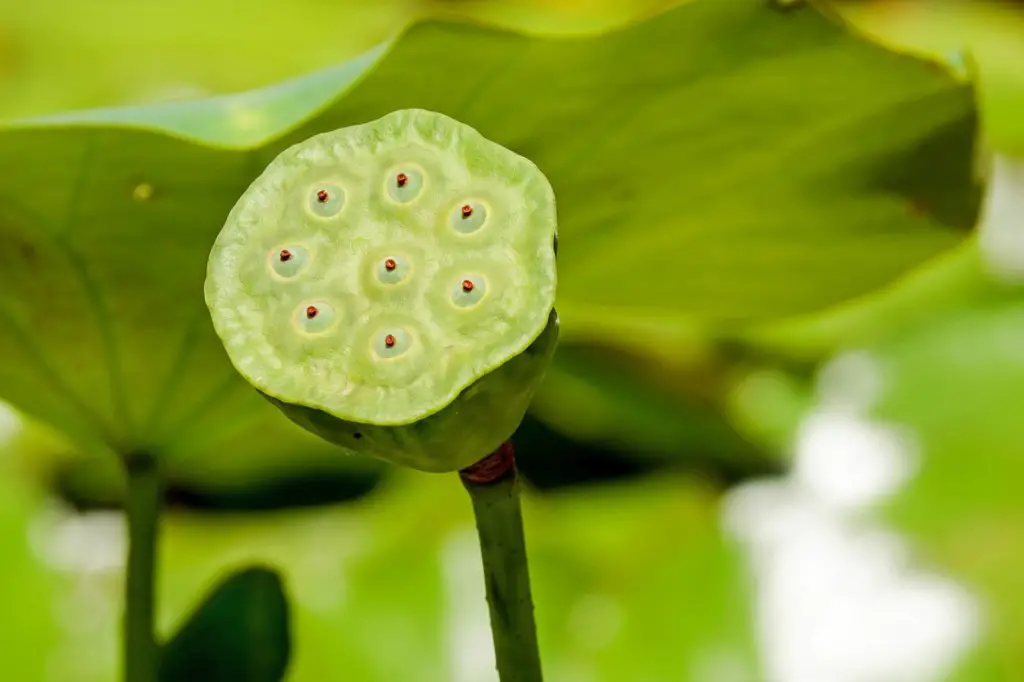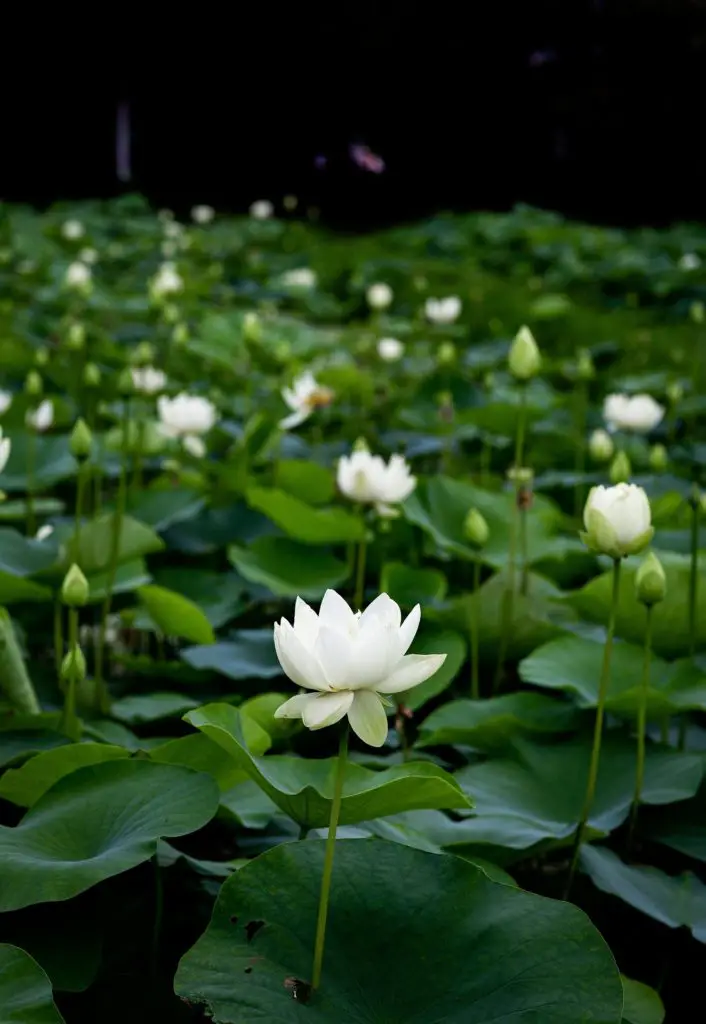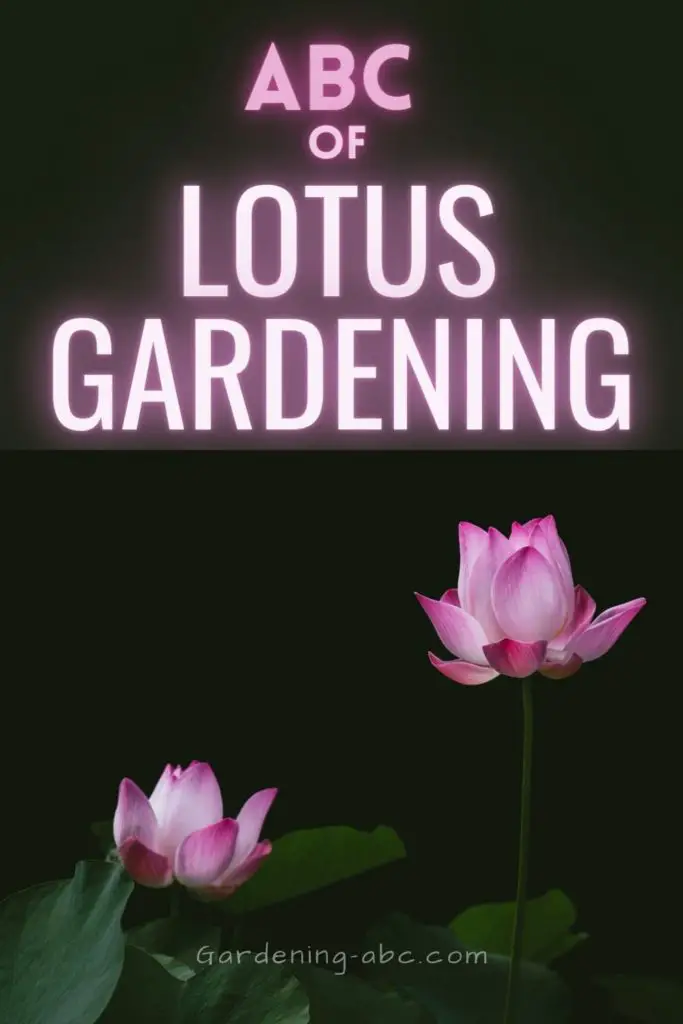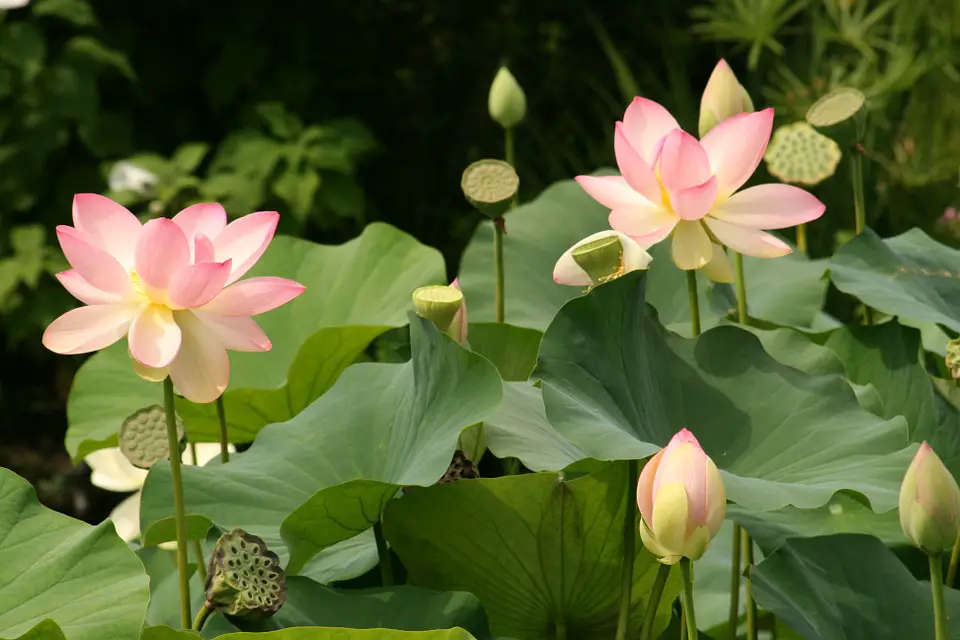We use affiliate links to run our site. When you buy through links on our site, we may earn an affiliate commission, without any added cost to you. Learn more
If you’re looking to add a bit of beauty to your home, why not try growing lotus flowers? A lotus flower is not only stunning, but it is also relatively easy to grow. With just a few supplies and some patience, you can have your own little oasis right in your backyard.
Here in this article, we will discuss how to grow a lotus flower at home in detail. You will learn details like planting lotus seeds, fertilizing lotus flowers, naturalizing, and others. This will be a post about taking care of your lotus plants at home.
Lotus plants sometimes get confused with Water Lilies but please remember those are two different plants.
Seems interesting? Let’s get started…
Lotus vs Water lily:
Lotus and Water lilies are not the same plants. Though they are closely related there are subtle differences between the two. Here are some of the major differences between them:
|
Lotus (Nelumbo sp) |
Water Lilies (Nymphaea sp) |
| The flowers and foliage are held on stalks above the water | The flowers and foliage pads generally float on the water’s surface |
|
Flowers and leaves are thin and papery. |
Thicker and waxy. |
|
Lotus petal is more rounded, sometimes ruffly. | The petal is pointed and creates a star-like bloom. |
|
Grow in 12 inches of water |
Grow in 2 to 5 feet of water |
|
lotus fragrance is more subtle | Has a strong scent at the time of bloom but that later fades. |
Lotus is an aquatic perennial plant. They are native to India. Lotus Flower is also the national flower of India. The lotus symbolizes purity, wealth, and also reincarnation. You can easily grow lotus as an indoor and outdoor plant.
Meanings of Lotus Flowers:
A lotus flower can represent quite a few things depending on its color.
| Color of the Flower |
What it represents |
|
Red Lotus Flower | Symbolizes passion |
|
White Lotus Flower | Symbolizes purity |
|
Yellowish (or golden) Lotus Flower | Symbolizes the Buddha himself |
|
Pink Lotus Flowers |
Symbolizes divinity. |
|
Blue Lotus Flower |
Symbolizes logic and wisdom |
How to Grow A Lotus Flower:
If you’re interested in growing your own lotus flower, there are a few things you need to know.
Where to Grow Lotus Plants:
Lotus is an aquatic plant. It grows best in full sun and aquatic features with no water flow. Flowing water disrupts the lotus plant’s growth and inhibits flowering.
The Ideal Soil for Growing Lotus:
Don’t use your traditional potting soil for growing a lotus plant. As the lotus is an aquatic plant, you have to submerge the growing pot in a pond. Potting mix is generally lightweight and if you put it underwater, the soil will float and you won’t be able to grow the plant.
Instead, use heavy topsoil like clay. Mix a small amount of organic compost with the clay and use it to grow your lotus plant. Typically a mix of 80% clay and 20% organic compost will be best for growing lotus plants.
Required Sunlight:
Lotus plants love sunlight. To bloom and thrive they need at least 6 hours of daily sunlight.
How to Plant Lotus Plant:
Growing a lotus plant is quite easy and fun. You can grow lotus either from a tuber or from a seed.
How to grow lotus flowers from seeds:
When it comes to planting lotus seeds, there are a few things you need to know in order to ensure a successful harvest. For starters, you need to make sure that the seeds are fresh – this is key in getting them to germinate.
planting lotus seeds:
Planting lotus seeds is relatively a simpler process. With the help of a file or knife scrape the hard seed coating and reveal the core seed. This will allow the water to enter the core of the seed. But don’t scrape the cream-colored seed core. This will damage the seed permanently.
Before planting lotus seeds, first, place the seeds in a bowl of warm water. Seeds should get drowned in water. The seeds that float are infertile. Remove them from the water.

Now soak the healthy seeds in water for a day. This will make the seeds swell up almost twice their original size. Keep the seeds in the water while changing the water daily. This will continue till they sprout and becomes ready for transplanting.
Use a mid-size (10 L to 20 L) container for planting those lotus sprouts. Unlike other containers that you use to grow plants, this container should not have any drainage holes.
The soil for growing lotus ideally has 2 parts clay and one part river sand. Never use commercial potting soil to grow lotus plants. Those soil mixes are lightweight and are good for growing plants in normal circumstances.
As we are going to submerge the container in water, the lightweight soil mix would float to the surface.
Once the lotus seedlings become a little stable, up to 6 inches long, we can now transfer them to the container that we have just prepared.
Sow the sprouted seeds into the soil with a gap of 4 inches. Instead of burying the seeds in the soil put the seed on the soil and give a light layer of soil to them.
Wrap a little bit of modeling clay at the bottom of each seed for anchorage. Otherwise, when you lower the container into the pond, the seeds might leave the soil and float up to the surface of the water.
Now, lower the pot into the pond. Make sure there are at least 2 to 4 inches of water above the soil.
For some lotus varieties (taller varieties) the water level needs to be as high as 18 inches. For dwarf lotus plants 2 to 12 inches of water is enough.
Maintain the water temperature around 70 °F. If you are growing lotus in a relatively cooler climate, provide extra warmth for your lotus.
Growing Lotus Plants From Tubers:
In most cases, people grow lotus plants from tubers. This is the bottom part of the plant that also has roots in it.
Sometimes when you buy tubers from nurseries it might look a bit wilted. There is nothing to worry about. You can grow lotus from these tubers too.
How to Plant Lotus Tubers:
For planting the tuber use a pot that doesn’t have any drainage holes. Now fill the pot with soil for about 4 inches. Water the soil lightly to make it wet. Don’t add more water at this stage.
Now Gently place the tuber with growth tips pointing upwards, on the surface of the wet soil, and cover it a little bit with soil.
Make sure that the growth tips should remain slightly above the soil and that the rest of the tuber should remain buried.
Spread a 2-inch-deep layer of coarse sand over the soil surface. The sand will keep the tuber in place. And will also prevent the soil from getting muddy. Embed the tuber into the sand and weigh it down with stones to keep it from floating.
next, fill the pot with more water until it reaches just above the growing tips. The growth tips of the tuber should be underwater at all times. Keep replenishing the water when it evaporates.
Place the pot in a place where it receives steady sunlight throughout the day.
After a few days, the lotus will break dormancy and you will see some aerial leaf growth. Now is the time to transfer your planting pot into a pond or a larger container that can hold quite a bit of water.
Eventually, the tuber will send roots into the soil and the lotus stems will emerge.
How to fertilize a lotus Flower:
First thing first, never apply any fertilizer before several floating leaves appear. Fertilizing too early can cause damage to the plants. Once you see some floating leaves appear before your eyes, apply a good soluble fertilizer once every 20 days.
It’s very important not to over-fertilize your lotus plants, it can really kill your plants especially when they are very small.
You can also use fertilizer in the powdered form. the trick is to wrap a small amount of the fertilizer in newspaper and place it under the soil in the container.
Another good fertilizer for lotus plants is commercial slow-releasing tablets like these. You can place them under the soil just like the powdered fertilizers.
Whatever method you choose to fertilize the lotus flower always read the direction mentioned in the packet.
How to Naturalize Lotus Plants:
For naturalizing lotus plants in a larger pond, anchor the tubers directly in the muddy bottom near the edge of the pond. From there they can spread easily.

Can You Grow Lotus Flowers Indoors?
Many people believe it is not possible to grow lotus flowers indoors but lotus can actually thrive indoors if you grow them properly. You have to arrange a container large enough to house its roots and can hold enough water to give the plant the necessary water depth.
Dwarf lotus varieties are better than larger varieties to grow indoors.
Problem with flowering? How To Get More Lotus Blooms:
Sometimes many growers have questions like why my lotus plant is not flowering. Though there can be many reasons for this here are some tips that will help you get the perfect bloom in your lotus plant:
1. Take the utmost care when planting your lotus plant. Whether you are growing lotus from seeds or tuber, if the planting is not right you will never see your desired result.
2. Sunlight is very important for the lotus plants. Make sure the plant gets 6 hours of daily sunlight. The flowering process can not be completed without enough sunlight.
3. Fertilizing aquatic plants like a lotus is different from terrestrial plants. Use a fertilizer that is specifically made for aquatic plants. If you did not choose the correct fertilizer the plant will suffer to bear flowers.
Whenever you buy pond plant fertilizers follow the direction specified in the pack.
Winter Care for Lotus Plant :
Lotus plants can easily withstand winter conditions as the tubers are not getting frozen. But if you live in cooler climates or the water level is not more than 6 inches higher than the tuber, move the plant container to a deeper part of the pond. There the tubers will be safe from freezing and the plant will do just fine.
Alternatively, you can remove the lotus plant and place it in a cool, dry location until spring.
Once things start to warm up in the early spring bring the plant back to its earlier location. The plant will soon start pushing new leaves.
Re-potting A Lotus Plant:
Just like any other container plants you have to re-pot lotus plants after some time. The best time to re-pot a lotus plant is in the Springs.
Carefully remove the tuber from the soil without damaging any growing points. See if the tuber is alright.
Replace any dead tuber and change the soil of the container. Then submerge the pot in water.
Where To Buy Lotus Plants:
The best place to buy lotus plants is your nearby nurseries. You can also use online stores to buy lotus plants.
Popular Varieties of Lotus Plant:
This aquatic perennial flower has many diverse subtypes of flowers. You can easily differentiate them by their roots or flowers. The difference can be in terms of the number of petals or colors.
Some of them have few petals, while others may have many. They also come in different colors: yellow, white, pink, and or red.
Some of the most common types of lotus flowers are:
- American Lotus (Nelumbo lutea)
- Vietnamese Lotus
- Angel Wings Lotus
- Sacred Lotus (Nelumbo nucifera)
- Royal Lotus
Is Lotus Plant Edible?
Lotus is also an edible plant. Almost all the parts of the plant are edible. Here are some of the examples:
Lotus seeds:
You can eat the seeds raw. When green they taste somewhat like peas, when they turn brown they taste more like nuts. Seeds are also used to make pastries and as flour in baking.
Lotus tubers:
The tubers taste more like sweet potatoes. You can eat them sliced, pickled, or cooked.
Lotus leaves and stems:
Can be eaten raw or cooked.
Lotus flowers:
You can dry them and use them in recipes for cooking.
Lotus plants are a good source of protein and in Asia, they are used as a sacred offering, food staple, and for their ornamental beauty.
Lotus Gardening in A Nutshell:
So to sum it up, here is the essence of how to grow lotus plants:
|
Scientific name |
Nelumbo sp |
|
Light and heat | Prefer full sunlight, and temperatures of at least 75 degrees F |
|
Soil |
A mix of 80% clay and 20% organic compost |
| Planting |
Plant seeds or tubers. |
|
Fertilizer |
Aquatic plant fertilizer (fast or slow release) |
|
Water depth |
At least 2” to 4” of water over the top of it |
|
Overwintering |
Move the plant to deeper areas of the pond |
| Re-potting |
Do it in the Springs |
|
Pests | Aphids, whitefly, and spider mites. |
|
Edibility | Most of the lotus plant is eaten, including the tuber, seed, stem, and leaf. |
Conclusion:
In conclusion, growing lotus plants at home are not as difficult as it may seem. With the proper care and attention, these beautiful flowers can thrive in any home. By following the simple steps outlined in this post, you can enjoy the beauty of lotus plants in your own home.
I hope this post was helpful. Here are some other flowers that you can try in your garden.
If you like the post, feel free to share it with others too.

Amazon and the Amazon logo are trademarks of Amazon.com, Inc, or its affiliates.

Hi there! My name is Prasenjit and I’m an avid gardener and someone who has grown a passion for growing plants. From my hands-on experience, I have learned what works and what doesn’t. Here I share everything I have learned.
